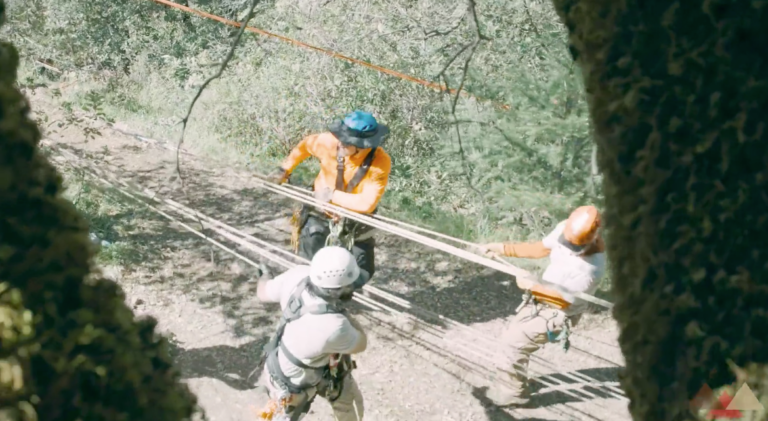Dynamic Directional Offset System Using an A-Frame and Natural High Directional
Dynamic directional offset systems are an innovative approach to technical rescue, offering strength, versatility, and adaptability for bridging large gaps and spans. By integrating a standard A-Frame Artificial High Directional (AHD) with natural high directional elements, this method provides a unique blend of support and flexibility, especially in challenging environments.
System Overview
The dual-nature configuration is the heart of this setup:
- A standard A-Frame on the Working Line side offers vertical stability.
- A dynamic or deflection system, using natural high directional elements, manages lateral motions while extending the system’s reach.
This system excels in its ability to adjust tension as needed, allowing for precise tightening or loosening based on environmental conditions. Effective communication is essential, particularly when external factors like running water or wind threaten to disrupt team coordination.
Key Functionalities
- The Working Line controls vertical movement, ensuring stability and direction.
- The Deflection Line facilitates lateral “in and out” or “out and back” motions, functioning similarly to reeving systems.
A crucial distinction is that deflection systems—and all offset configurations—are not designed to function as highlines. Maintaining deep angles and avoiding excessive tension is essential for safe and efficient operation. Additionally, incorporating a dedicated belay line for the deflection system is strongly recommended to enhance safety.
Critical Components of the Dynamic Directional Offset System
- Working Line:
The backbone of vertical control, ensuring the system remains stable and precise. Learn more about Working Line Configurations. - Deflection Line:
Manages lateral movement, providing the flexibility needed to navigate obstacles and adapt to complex terrains. Explore our guide on Deflection Systems. - Artificial High Directionals (AHD):
AHD systems, like A-Frames, extend reach and enhance system versatility, especially when combined with natural anchors. Check out our article on AHD Systems and Techniques. - Anchors:
Serve as the foundation for system integrity, ensuring safety and operational stability. For anchor setup tips, visit Anchor Systems in Rescue. - Tensioning Systems:
Allow precise control over system tension, accommodating the dynamic needs of each operation. Learn more about Tensioning Techniques.
Why This Method Works
Dynamic directional offset systems excel in scenarios requiring adaptability, such as large spans, where traditional setups may fall short. By leveraging the strengths of A-Frames and natural high directionals, this configuration balances precision with flexibility, ensuring safe and efficient operations.
This video provides a detailed walkthrough of the setup and execution of dynamic directional offsets, emphasizing:
- The strategic integration of A-Frames and natural high directionals.
- Techniques for managing system tension.
- The critical role of communication in dynamic rescue operations.
Advancing Rescue Operations
Dynamic directional offsets represent a cutting-edge approach to technical rescue, combining innovative techniques with practical adaptability. By mastering the setup and operation of these systems, rescue teams can tackle complex challenges with greater safety, efficiency, and teamwork.
For additional insights on dynamic systems, AHD configurations, and technical rescue techniques, visit our Rope Rescue Systems Resource Hub.
Peace on your days,
Lance
Peace on your Days
Lance









